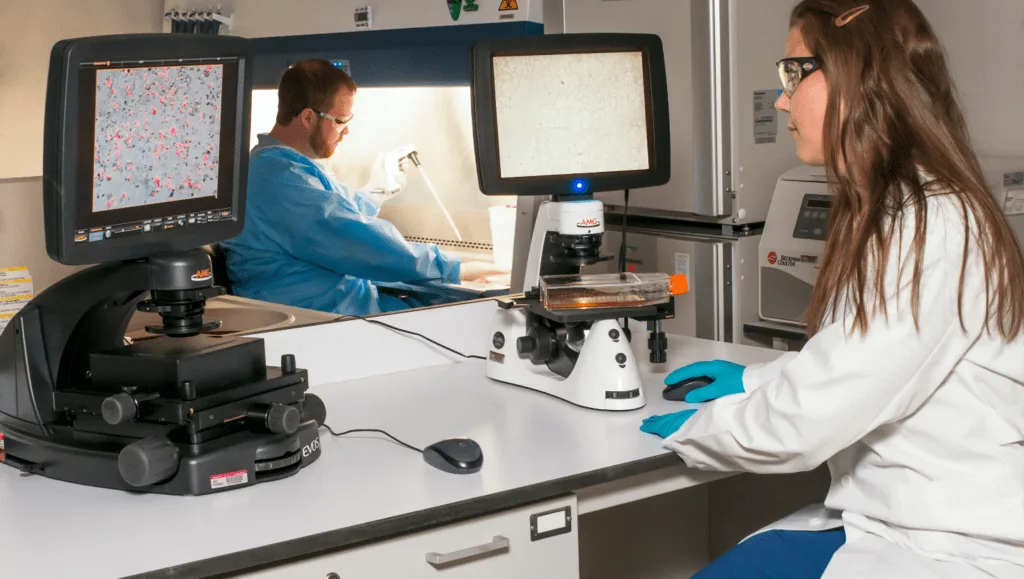Cell counting plays a crucial role in various biological and medical research fields, from cell culture to cancer research and drug discovery. An automated cell counter offers a faster, more accurate, and reproducible method than manual counting, minimizing user variability and increasing efficiency in the laboratory.
In this article, we will explore the benefits of using an automated cell counter, examine the different types available, and highlight key technical specifications. By understanding these factors, you can select the right automated cell counter for your lab’s needs.
Why Choose an Automated Cell Counter?
Manual cell counting with a hemocytometer and microscope is time-consuming and prone to human error. With an automated cell counter, you gain:
- Speed and Efficiency – Count thousands of cells in seconds.
- Improved Accuracy – Reduces user bias, providing reliable and reproducible results.
- Fluorescence Compatibility – Advanced models can differentiate live and dead cells using fluorescent dyes.
- Reproducibility – Ensures consistent results across multiple tests for dependable data analysis.
Key Applications of Automated Cell Counters
Automated cell counters are utilized in a variety of applications, including:
- Cell Culture & Maintenance – Achieve optimal cell concentration for successful experiments.
- Biopharmaceutical Research – Evaluate cell viability during drug screening.
- Stem Cell & Cancer Research – Characterize cell populations for research advancements.
- Organoid Research – Specialized algorithms for complex 3D structures.
- Flow Cytometry Sample Preparation – Measure cell density accurately before analysis.
Types of Automated Cell Counters
Automated cell counters can be divided into two main categories based on their detection method:
1. Brightfield (Trypan Blue) Cell Counters
- Uses brightfield microscopy and trypan blue dye to differentiate live (unstained) and dead (blue-stained) cells.
- Ideal for general cell culture applications, including mammalian cells and stem cells.
- Common models: RWD C100 Automated Cell Counter
2. Fluorescence Cell Counters
- Utilizes fluorescent dyes such as propidium iodide (PI) or acridine orange (AO) to distinguish live, dead, and specific cell subpopulations.
- More precise than trypan blue, particularly for small or difficult-to-detect cells.
- Suitable for primary cells, PBMCs, and organoids.
- Common models: RWD Fluorescent Cell Counter, Axion Exact FL
Trypan Blue vs. Fluorescent Cell Counting – Which Method to Choose?
| Feature | Trypan Blue Staining | Fluorescence Staining |
| Principle | Excludes dead cells using trypan blue dye | Uses fluorescent dyes to label live/dead cells |
| Accuracy | Moderate; some risk of underestimating viability | High; ideal for small/low-contrast cells |
| Best for | Routine cell culture and viability assessments | Sensitive applications (PBMCs, stem cells, organoids) |
| Cost | More affordable | Higher cost due to fluorescence reagents |
For general cell culture, a trypan blue-based counter like the RWD C100 will meet your needs. However, for applications involving primary cells, PBMCs, or complex samples like organoids, a fluorescence-based counter like the Axion Exact FL offers superior accuracy.
Advanced Features of the Axion Exact FL for Organoid Research
The Axion Exact FL is designed with specialized software for organoid research, offering:
- AI-Powered Image Analysis – Automatically detects and analyzes organoids without manual intervention.
- Multi-Channel Fluorescence Detection – Differentiates live, dead, and subpopulations within organoid structures.
- 3D Cell Counting Algorithms – Effectively analyzes clumped or irregularly shaped organoids.
For researchers working with spheroids, organoids, and 3D cell cultures, the Axion Exact FL is an excellent choice.
Key Factors to Consider When Choosing an Automated Cell Counter
1. Type of Cells Being Counted
- Consider whether you’re counting suspension cells, adherent cells, PBMCs, stem cells, or organoids.
- Do you need fluorescence detection for greater accuracy?
2. Throughput & Speed
- How many samples will you process each day? Some models offer batch processing for high-throughput applications.
3. Counting Chamber & Consumables
- Does the device require proprietary slides, or can it use reusable chambers? Consider the cost of consumables in the long run.
4. Software & Data Analysis
- Does the system integrate with your current lab software? Look for systems that provide automatic data export and advanced analysis tools.
5. Budget & Cost of Ownership
- Factor in both the initial purchase price and long-term expenses, including consumables and maintenance costs.
Conclusion
Selecting the right automated cell counter for your laboratory needs depends on various factors, such as cell type, accuracy requirements, throughput, and budget. For general viability assessments, a trypan blue-based counter like the RWD C100 offers a cost-effective solution. However, for more sensitive research involving primary cells or organoids, a fluorescence-based counter like the Axion Exact FL will provide the highest level of precision.
Explore Apex Scientific’s selection of automated cell counters or contact our experts to help you make the right choice for your lab.




